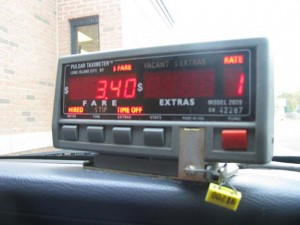If anything will help sell Americans on the wave of new electric vehicles just coming to market it’s the idea of skipping the gas pumps. Makers like Nissan – which is just rolling its new Leaf battery car into showrooms – are quick to point out that you’ll pay barely 2 cents a mile for the electricity needed to charge up, compared to a dime or more to propel a comparable gas-powered vehicle.
But one reason you’ll save money is that you’re not paying the nearly 50 cents a gallon in federal and state gasoline excise taxes which, for the average vehicle, can add up to almost $500 a year in taxes. For cash-strapped governments that’s hard to ignore, and the State of Oregon has already established a committee to find ways to make up that money.
If your electric vehicle doesn’t pay its taxes at the pump you may eventually have to cough up cash some other way, perhaps, Oregon regulators are considering, by using a per-mile fee that could add another penny or two per mile.
But regulators aren’t the only ones considering that option. It’s an idea the insurance industry loves, as it gives them a chance to track not just how much you drive but, potentially where and how you drive.
Progressive Insurance is, this week, rolling out its new Snapshot program for Michigan drivers. Those who participate install a small monitoring device that’s not much bigger than a garage door opener. But in this case, it unlocks your personal driving information for the insurance company to monitor.
If you sign up for the Snapshot program, the monitor will not only track how far you are going but how fast. It will record when you hit your brakes – and even how hard.
In Progressive’s case, the company is actually looking to see how you fit into its driving profile, so your precise discount depends more on your behavior than specifically the distances you clock. Insurers prefer to write policies for low-risk motorists.
But at least 10 automotive insurance companies, operating in 35 states, are now offering so-called pay-as-you-go policies that are directly tied to the distance you drive. GMAC and State Farm, for example, use data that can capture through the OnStar system in General Motors vehicles to track your mileage.
A report by the Brookings Institution suggests that up to two-thirds of American drivers would actually see a reduction in their insurance bills under mileage-based programs, with savings of up to $270 a year.
MileMeter, an online company now providing insurance in Texas but set to expand nationwide, skips the vehicle tracker and simply requires customers to send in photos of their odometer. The firm’s unusual approach is to sell a motorist insurance by the mile or, more precisely, in 6,000 mile increments. When you’re about to go over you “refill” your bucket much like some customers do with pay-per-minute cellphone service.
“I like the idea of getting a big discount. My auto insurance is too expensive,” says Carrie Swate, a suburban Detroit nurse. But she also admits she finds it “a little too much like Brother” to be recording everything she does behind the wheel, like Progressive would require.
The insurer has nonetheless been ramping up the program and improving the technology, using cash incentives of up to a 30% discount to so far lure in more than 100,000 motorists in 27 states.
Whether pay-per-mile insurance programs catch on big or remain a niche for those who already expect a big discount remains to be seen, but what about when it comes to road taxes.
Though the Oregon Department of Transportation has a task force studying just that possibility, spokesman David House cautions that, for now, “it is nothing but a proposal, an idea.”
But Mary D. Nichols, Chairman of the California Air Resources Board acknowledges, “It is an issue we will have to deal with.”
And battery cars aren’t the only reason. Even if vehicles like the Nissan Leaf or Chevrolet Volt falter, the government faces the very real threat that gasoline excise tax revenues will decline, perhaps precipitously. As TheDetroitBureau.com reported earlier this week, the nation’s has seen an 8% decline in the use of gasoline since fuel consumption peaked in 2006. And by 2030, many experts now forecast, gasoline usage could plunge by a third or more.
One possibility is to increase the excise tax, which hasn’t been raised in two decades, something now under discussion in Washington. But in the era of the Tea Party, even such modest proposals to maintain revenues officially earmarked specifically for transportation purposes could be difficult to pass.
So, a per-mile alternative might prove more attractive. To some, it would smack of Big Brother-ism, but to others it would be a classically American approach, each driver paying for exactly what they “use.”
One thing is certain, the debate over paying per mile is only going to get louder in the years to come.


Yeah, right, that’s why we all like to pay as we go for Internet, basic phone, cable, uh, not. Just another reason to dislike Progressive… and Oregon.